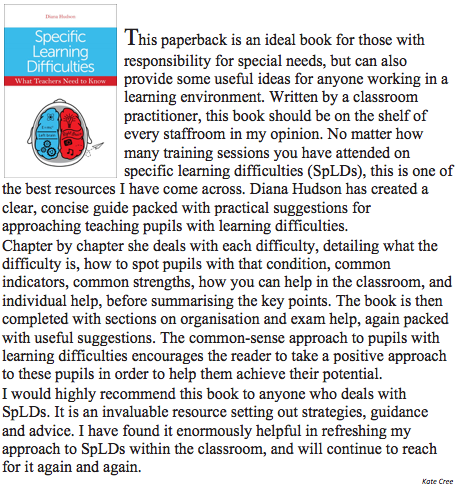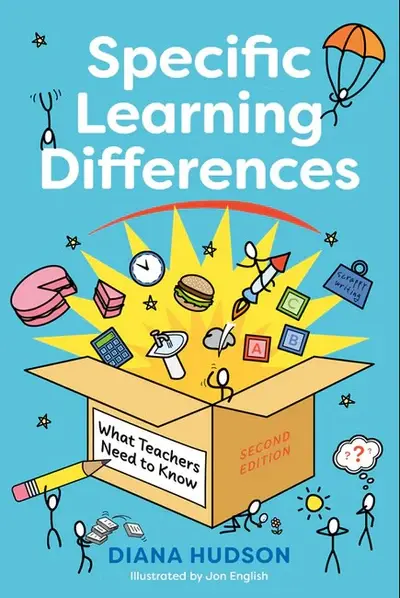- Home
- Numicon NZ Website
- About Us
- Numicon
- Professional Development/Events
- FREE online PD recordings
- Login
- Contact
- Join Mailing List
- Conference 2026
Specific Learning Differences - What Teachers Need to Know
The updated, straight-talking and accessible guide is ideal for teachers, teaching assistants, SENCOs, senior leadership and even home schooling parents who want to know more about supporting students with Learning Differences.
Highlighting some of the more commonly encountered Specific Learning Differences (SpLDs), expert Diana Hudson concisely describes the signs of those that are most commonly encountered in the classroom. Covering: dyslexia, dyspraxia, dyscalculia, dysgraphia, autism spectrum condition, ADHD, OCD and featuring brand new chapters on Pathological Demand Avoidance (PDA), Sensory Processing Disorder (SPD) and tics and Tourette Syndrome, this book covers all the information you need, whilst reminding us that all neurodivergent children are individuals and have different qualities.
Diana provides an overview of each identity and evaluates how you may need to adapt your levels of support in the classroom - as well as practical suggestions for modifying teaching materials and methods to make learning enjoyable, effective and accessible for all students. There are also dedicated chapters on helping students with SpLDs to improve their organisation and develop effective revision skills and exam techniques.
Highlighting some of the more commonly encountered Specific Learning Differences (SpLDs), expert Diana Hudson concisely describes the signs of those that are most commonly encountered in the classroom. Covering: dyslexia, dyspraxia, dyscalculia, dysgraphia, autism spectrum condition, ADHD, OCD and featuring brand new chapters on Pathological Demand Avoidance (PDA), Sensory Processing Disorder (SPD) and tics and Tourette Syndrome, this book covers all the information you need, whilst reminding us that all neurodivergent children are individuals and have different qualities.
Diana provides an overview of each identity and evaluates how you may need to adapt your levels of support in the classroom - as well as practical suggestions for modifying teaching materials and methods to make learning enjoyable, effective and accessible for all students. There are also dedicated chapters on helping students with SpLDs to improve their organisation and develop effective revision skills and exam techniques.
Diana Hudson is a tutor and mentor to students with Specific Learning Difficulties (SpLD), as well as a subject classroom teacher (biology) and learning support teacher and SENCO. She has a diagnosis of dyslexia, and is a parent to four children, three of whom have been diagnosed with SpLD. Diana lives in Buckinghamshire, UK.
Contents
Acknowledgements.
Introduction.
1. Brains that work a little differently: Introducing Specific Learning Difficulties.
2. Dyslexia.
3. Dyscalculia.
4. Dysgraphia.
5. Dyspraxia.
6. Attention Deficit Hyperactivity Disorder (ADHD).
7. Autism Spectrum Disorder (ASD) and Asperger's Syndrome.
8. Obsessive Compulsive Disorder (OCD).
9. Organisational skills.
10. Exams and revision.
11. A final word.
Appendix: Summary of common areas of difficulty. Glossary. Further reading. References. Index.
Reviews
Specific Learning Difficulties
Diana Hudson
What Teachers Need to Know
An easy-to-read handbook, highlighting SpLD’s and how best to include students in the classroom.
From a teacher’s perspective, I have seen a range of SpLD’s and observed the severe and less severe presentations in the classroom, noticing the spectrum SpLD students inevitably fall on. Along with a range of other behaviour and social issues teachers have in their class, SpLD’s can either stand out or lose themselves amongst the throng of culturally and socio-economically diverse children. To recognize and diagnose an SpLD as soon as possible can only be of benefit, especially if the professionals involved are aware of their responsibilities when teaching students with SpLD’s. Unfortunately, it has been my experience, that many parents will deny any formal diagnosis, hoping it is a phase and the child will grow out of it. As a teacher in the year 5/6 area, I met many parents who finally accepted professional feedback because the gap was widening and their child was falling further and further behind their peers.
The book is set out well, it’s organized, it is logically sequenced and easy to follow and read. Professionals and parents would find this book a helpful handbook and when kept at the ready, it can support teachers when observing, planning for and teaching not just SpLD’s, but all students.
Having read and heard differing opinions on learning styles, I like that D. Hudson has highlighted learning styles and followed up with best practise approaches when setting learning tasks in the classroom and for homework. I have always, ‘said, shown and demonstrated’ my lessons, appealing to the different learning styles of my students.
Stressing a multi-sensory approach to all curriculum subjects reminds me of just how important it is for educators to have time to plan and execute fewer lessons, however, allowing time to explore, question, trial, compare, converse etc. ( Horizontal teaching rather than vertical). Classrooms are very busy places now, reflecting the ‘cultural norm of busyness’ in our society. Interruptions, full calendars, government agendas, leadership responsibilities, community expectations, loaded curriculums and students bringing diverse home-life experiences can make the planning of an educationally sound programme that is meeting all the student’s needs, challenging. The ‘During Lessons,’ sections in her book gives supportive tips on how to best support, not only SpLD’s in the classroom, but, the other students as well.
The upsides and downsides are helpful when determining if suspicions are correct or not when making professional assumptions about a student. We had similar lists when I first began teaching, helping us to determine if a student was gifted or not. Interestingly, many upsides are what we’d be observing in giftedness.
The main idea I came away with after reading this book, was what ‘Best Practice’ looks like in the classroom. Teachers really do have a diverse student body and they have to be supported well with regular P.D, sensitive leadership, sound theological approaches and a professional culture that’s willing to take risks, make mistakes, communicate sensitively and make choices based on student needs.
I would recommend this book be in the classroom of all teachers and that it be used as a handbook when planning, holding meetings and when attempting to identify a SpLD.
Amanda Foot

Associated Items
View your shopping basket or Browse other items in Learning Needs.

